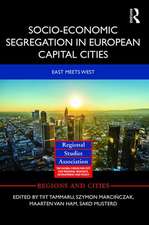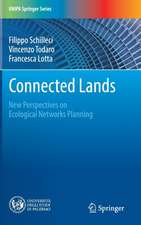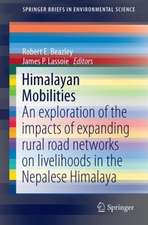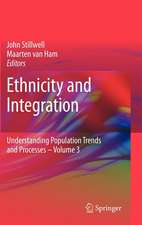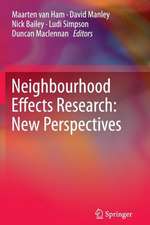Housing Estates in Europe: Poverty, Ethnic Segregation and Policy Challenges: The Urban Book Series
Editat de Daniel Baldwin Hess, Tiit Tammaru, Maarten van Hamen Limba Engleză Hardback – 28 aug 2018
This open access book explores the formation and socio-spatial trajectories of large housing estates in Europe. Are these estates clustered or scattered? Which social groups originally had access to residential space in housing estates? What is the size, scale and geography of housing estates, their architectural and built environment composition, services and neighbourhood amenities, and metropolitan connectivity? How do housing estates contribute to the urban mosaic of neighborhoods by ethnic and socio-economic status? What types of policies and planning initiatives have been implemented in order to prevent the social downgrading of housing estates?
The collection of chapters in this book addresses these questions from a new perspective previously unexplored in scholarly literature. The social aspects of housing estates are thoroughly investigated (including socio-demographic and economic characteristics of current and past inhabitants; ethnicity and segregation patterns; population dynamics; etc.), and the physical composition of housing estates is described in significant detail (including building materials; building form; architectural and landscape design; built environment characteristics; etc.). This book is timely because the recent global economic crisis and Europe’s immigration crisis demand a thorough investigation of the role large housing estates play in poverty and ethnic concentration. Through case studies of housing estates in 14 European centers, the book also identifies policy measures that have been used to address challenges in housing estates throughout Europe.
| Toate formatele și edițiile | Preț | Express |
|---|---|---|
| Paperback (1) | 309.54 lei 38-44 zile | |
| Springer International Publishing – 20 dec 2018 | 309.54 lei 38-44 zile | |
| Hardback (1) | 405.36 lei 38-44 zile | |
| Springer International Publishing – 28 aug 2018 | 405.36 lei 38-44 zile |
Din seria The Urban Book Series
- 15%
 Preț: 655.27 lei
Preț: 655.27 lei - 15%
 Preț: 640.06 lei
Preț: 640.06 lei - 15%
 Preț: 643.16 lei
Preț: 643.16 lei - 18%
 Preț: 1007.35 lei
Preț: 1007.35 lei - 15%
 Preț: 648.56 lei
Preț: 648.56 lei - 18%
 Preț: 1003.38 lei
Preț: 1003.38 lei - 15%
 Preț: 642.18 lei
Preț: 642.18 lei - 18%
 Preț: 963.15 lei
Preț: 963.15 lei - 18%
 Preț: 948.92 lei
Preț: 948.92 lei - 15%
 Preț: 649.87 lei
Preț: 649.87 lei - 18%
 Preț: 731.59 lei
Preț: 731.59 lei - 18%
 Preț: 783.50 lei
Preț: 783.50 lei - 18%
 Preț: 894.46 lei
Preț: 894.46 lei - 18%
 Preț: 897.02 lei
Preț: 897.02 lei - 15%
 Preț: 648.24 lei
Preț: 648.24 lei - 18%
 Preț: 949.42 lei
Preț: 949.42 lei - 18%
 Preț: 731.10 lei
Preț: 731.10 lei - 15%
 Preț: 649.87 lei
Preț: 649.87 lei - 15%
 Preț: 639.37 lei
Preț: 639.37 lei - 18%
 Preț: 950.52 lei
Preț: 950.52 lei - 15%
 Preț: 644.95 lei
Preț: 644.95 lei - 15%
 Preț: 640.06 lei
Preț: 640.06 lei - 18%
 Preț: 1126.52 lei
Preț: 1126.52 lei - 15%
 Preț: 645.60 lei
Preț: 645.60 lei - 15%
 Preț: 649.87 lei
Preț: 649.87 lei - 18%
 Preț: 1415.66 lei
Preț: 1415.66 lei - 15%
 Preț: 647.73 lei
Preț: 647.73 lei - 18%
 Preț: 793.32 lei
Preț: 793.32 lei - 18%
 Preț: 892.90 lei
Preț: 892.90 lei - 15%
 Preț: 659.70 lei
Preț: 659.70 lei - 18%
 Preț: 1004.99 lei
Preț: 1004.99 lei - 15%
 Preț: 645.79 lei
Preț: 645.79 lei - 18%
 Preț: 735.84 lei
Preț: 735.84 lei - 20%
 Preț: 564.40 lei
Preț: 564.40 lei - 18%
 Preț: 892.90 lei
Preț: 892.90 lei - 18%
 Preț: 952.09 lei
Preț: 952.09 lei - 15%
 Preț: 641.71 lei
Preț: 641.71 lei - 18%
 Preț: 1009.70 lei
Preț: 1009.70 lei - 18%
 Preț: 1401.61 lei
Preț: 1401.61 lei - 18%
 Preț: 1109.16 lei
Preț: 1109.16 lei - 15%
 Preț: 648.24 lei
Preț: 648.24 lei - 18%
 Preț: 726.37 lei
Preț: 726.37 lei - 18%
 Preț: 728.28 lei
Preț: 728.28 lei - 18%
 Preț: 894.46 lei
Preț: 894.46 lei - 18%
 Preț: 1000.24 lei
Preț: 1000.24 lei - 15%
 Preț: 640.06 lei
Preț: 640.06 lei - 18%
 Preț: 998.66 lei
Preț: 998.66 lei - 15%
 Preț: 657.90 lei
Preț: 657.90 lei
Preț: 405.36 lei
Nou
Puncte Express: 608
Preț estimativ în valută:
77.56€ • 81.20$ • 64.18£
77.56€ • 81.20$ • 64.18£
Carte tipărită la comandă
Livrare economică 02-08 aprilie
Preluare comenzi: 021 569.72.76
Specificații
ISBN-13: 9783319928128
ISBN-10: 3319928120
Pagini: 325
Ilustrații: XIV, 424 p. 118 illus., 74 illus. in color.
Dimensiuni: 155 x 235 mm
Greutate: 0.89 kg
Ediția:1st ed. 2018
Editura: Springer International Publishing
Colecția Springer
Seria The Urban Book Series
Locul publicării:Cham, Switzerland
ISBN-10: 3319928120
Pagini: 325
Ilustrații: XIV, 424 p. 118 illus., 74 illus. in color.
Dimensiuni: 155 x 235 mm
Greutate: 0.89 kg
Ediția:1st ed. 2018
Editura: Springer International Publishing
Colecția Springer
Seria The Urban Book Series
Locul publicării:Cham, Switzerland
Cuprins
Introduction: The Role of Large Housing Estates in Past, Present and Future Change in European Cities.- PART 1: Four Thematic Lenses for Viewing the Trajectories of Large Housing Estates.- PART 2: Case Studies of Housing Estates in European Metropolitan Area.- Western Europe (Changing Context, Policies and Estates in the UK: The Birmingham Example / The Socio-economic Evolution of Large Housing Estates in Brussels / Large Housing Estates in a Divided City: Berling's Pallenbauten and Wohnblöcke / Large Housing Estates in the Paris Region: The Local Challenge of Internal Social Mixing in Orly).- Eastern Europe (Persistence or Change: Social and Physical Challenges of Housing Estates in Budapest / Housing Estates in Prague: Long-term Development and Current Situation / Mass Housing Inherited from State Socialism in Tartu, Estonia / Ursynów: Emergence and Evolution of Warsaw's Largest Dormitory Suburb).- Northern Europe (Equity or Net Gains? Tenure Structure, Perceived Social Disorder andPolicy Challenges in the Post-WWII Housing Estates of Helsinki region / Large Housing Estates in Stockholm: Do Initial Conditions Matter?).- Southern Europe (Social and Ethnic Transformations of Large Social Housing Estates in Milan: From Modernity to Marginalisation / Large housing Estates in Athens: An Uncommon Form of Social Housing Within a Residual Welfare State.- Conclusion (Assessing the Evidence: Past and Present Trajectories of Europe's Large Housing Estates, and a Comment on the Future).- Index.
Recenzii
“I would undoubtedly recommend the book to anyone interested in the legacy of modernist planning.” (Adam Radzimski, Eurasian Geography and Economics, March 2, 2020)
“This new book by Hess, Tammaru and Van Ham expands on [an] earlier project by adding more and newer evidence from an even larger number of countries and by identifying successful policies and programs that maintain the quality of these large housing estates as positive places to live for low- and middle-income households. I would recommend this book to academics who work on issues like segregation and concentration of socioeconomically deprived populations in urban space specifically.” (Karien Dekker, Journal of Urban Affairs, Vol. 42 (1), 2020)
“I strongly recommend [this book] to housing scholars and practitioners on both sides of the Atlantic. The editors and the publisher, Springer Open, deserve credit for publishing two attractive and useful books that address the breadth and depth of issues related to housing estate revitalization across Europe. The numerous photographs (color as well as black-white) throughout the book helped me to understand changes in the design of European housing estates—the good as well as the bad.” (David P. Varady, Geography Research Forum, Vol. 39, 2019)
Notă biografică
The three co-editors are experts in urban geography, city planning, urban morphology, social exclusion, and segregation and inequity. They are currently pursuing research about change in European cities and urban neighborhoods with the most intractable challenges.
Daniel Baldwin Hess is Professor and Chairperson in the Department of Urban and Regional Planning at the University at Buffalo, State University of New York. He is also Visiting Scholar and former Director of the Centre for Migration and Urban Studies at the University of Tartu, Estonia, where he was a Marie Skłodowska-Curie Fellow. His research contributes new pathways for understanding the complex socio-economic and ethnic landscape of cities and spatial inequalities. He is a former Fulbright Scholar at Tallinn University of Technology in Estonia and winner of a National Endowment for the Humanities Fellowship.
Tiit Tammaru is Professor in the Centre for Migration and Studies at the University of Tartu, in Estonia. He is the lead editor of Socio-economic segregation in European capital cities: east meets west (Routledge, 2016). Tammaru is also the Head of the Centre for Estonian Diaspora Studies and has received both the Estonian Science Award in social sciences in 2010 and the Natural Sciences Award in 2011. His fields of interest include socio-spatial inequality, geographical changes in urban regions, governing urban diversity and social mobility.
Maarten van Ham is Professor of Urban Renewal and Head of the Neighbourhood Change and Housing Research Group at OTB - Research for the Built Environment at Delft University of Technology, in the Netherlands. Van Ham is a population geographer with a background in economic and urban geography. He is a Research Fellow at IZA (a large economic research institute in Germany) and Professor of Geography at the University of St. Andrews in Scotland. Since2014, he is head of the ERC project DEPRIVEDHOODS, a 5-year research project on neighbourhood effects
Textul de pe ultima copertă
This open access book explores the formation and socio-spatial trajectories of large housing estates in Europe. Are these estates clustered or scattered? Which social groups originally had access to residential space in housing estates? What is the size, scale and geography of housing estates, their architectural and built environment composition, services and neighbourhood amenities, and metropolitan connectivity? How do housing estates contribute to the urban mosaic of neighborhoods by ethnic and socio-economic status? What types of policies and planning initiatives have been implemented in order to prevent the social downgrading of housing estates?
The collection of chapters in this book addresses these questions from a new perspective previously unexplored in scholarly literature. The social aspects of housing estates are thoroughly investigated (including socio-demographic and economic characteristics of current and past inhabitants; ethnicity and segregation patterns; population dynamics; etc.), and the physical composition of housing estates is described in significant detail (including building materials; building form; architectural and landscape design; built environment characteristics; etc.). This book is timely because the recent global economic crisis and Europe’s immigration crisis demand a thorough investigation of the role large housing estates play in poverty and ethnic concentration. Through case studies of housing estates in 14 European centers, the book also identifies policy measures that have been used to address challenges in housing estates throughout Europe.
Caracteristici
Focuses on people-based and placed-based complex challenges of housing estates Addresses issues from a new perspective previously unexplored in scholarly literature Thoroughly investigates the role of large housing estates in poverty and ethnic concentrations




